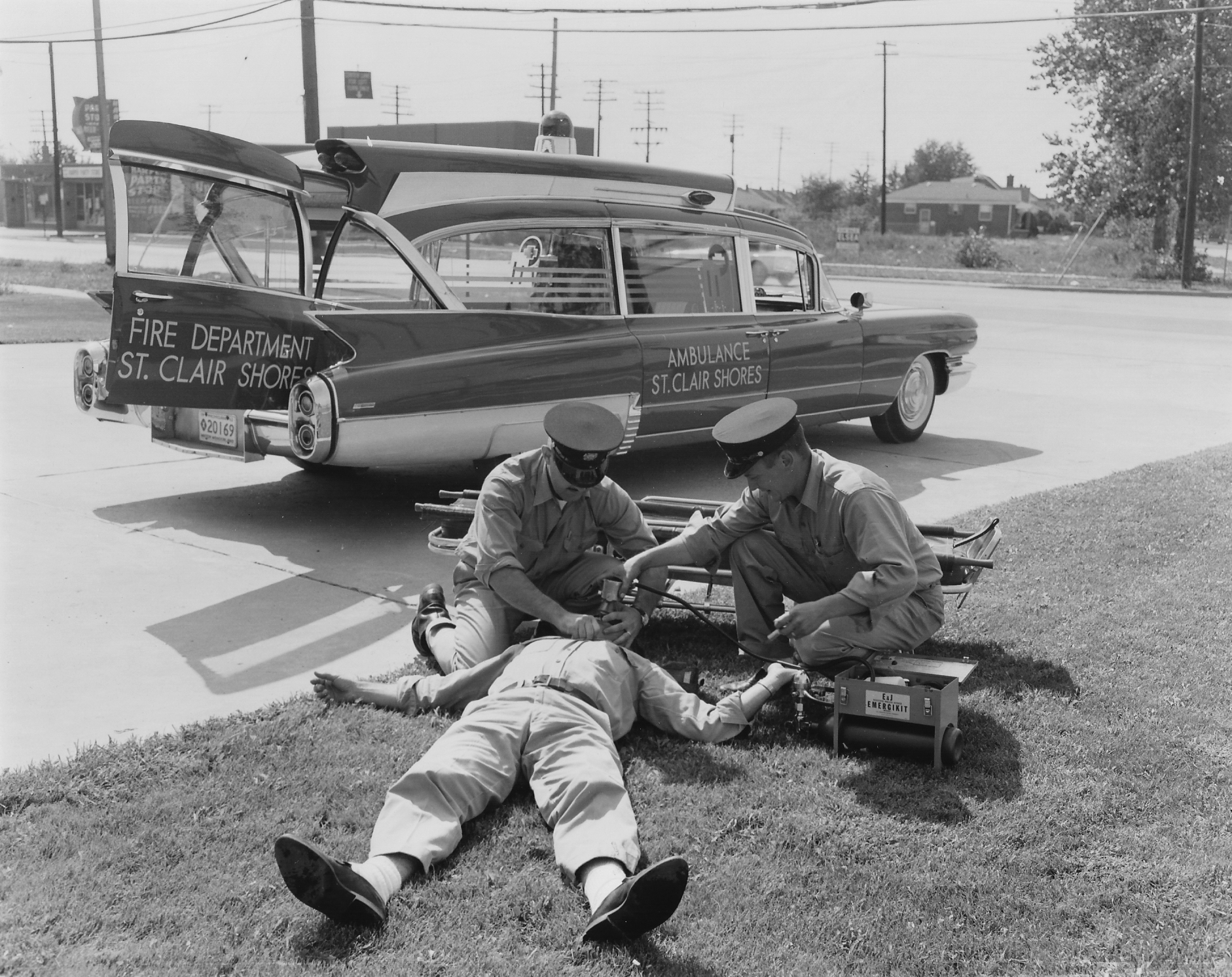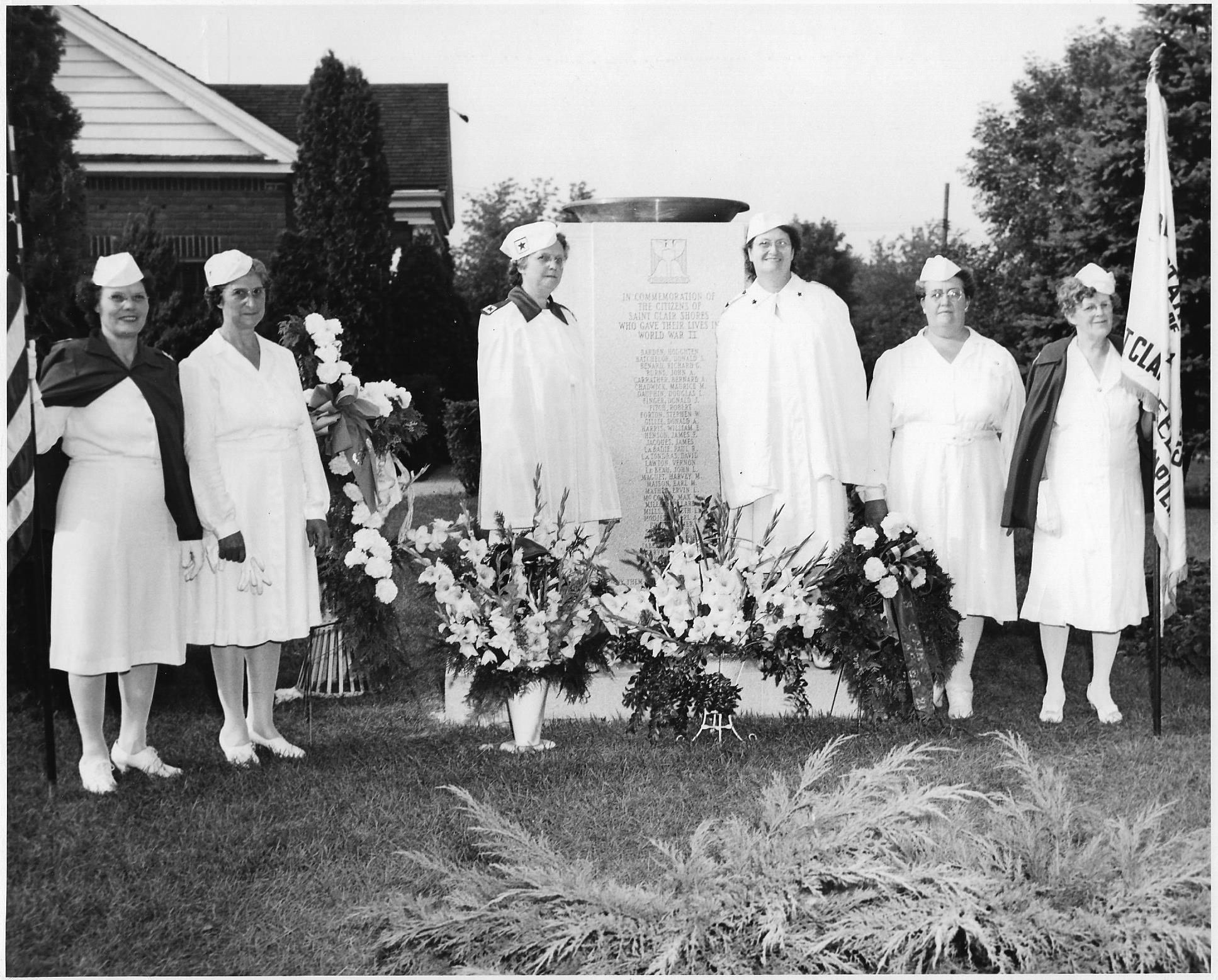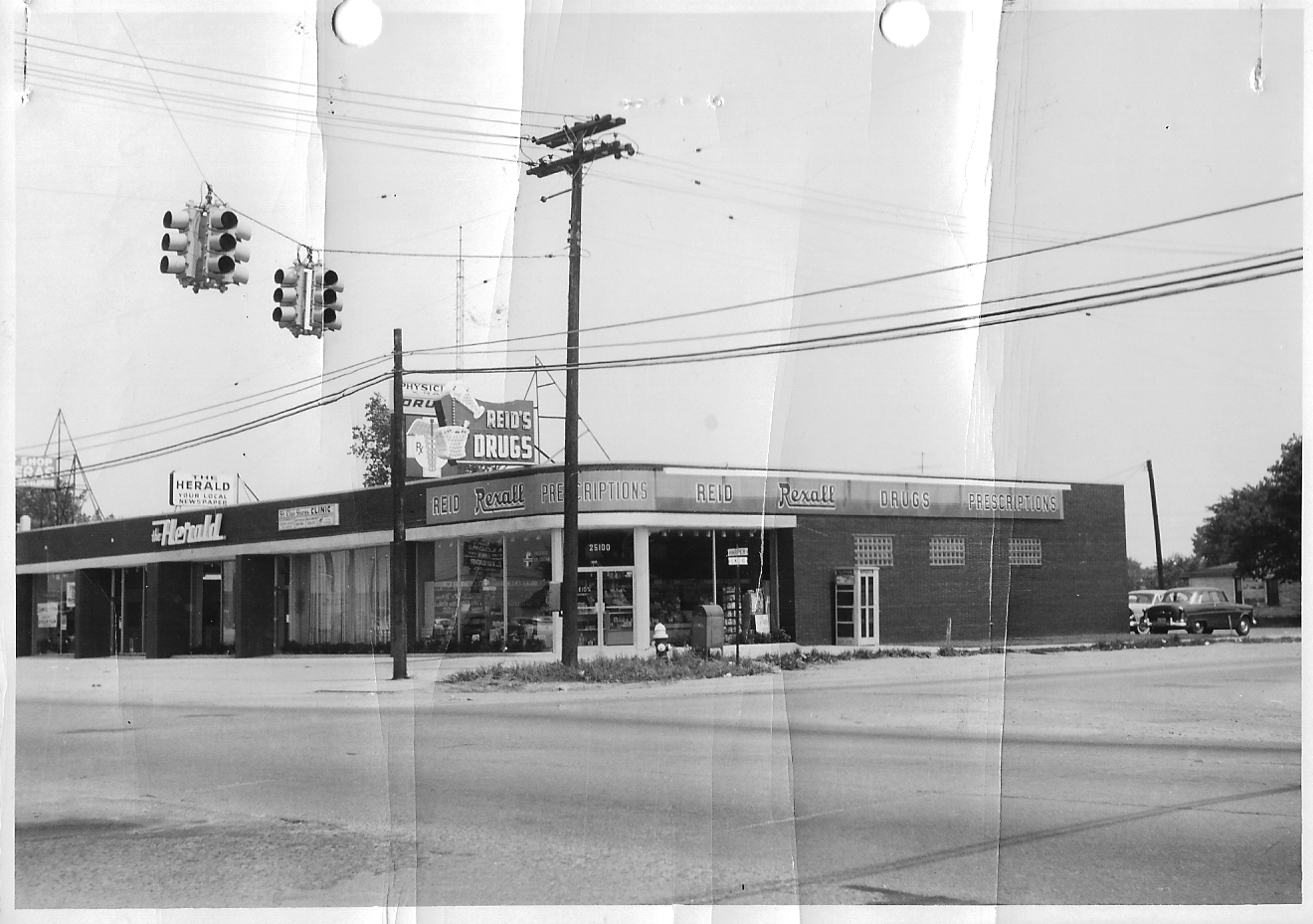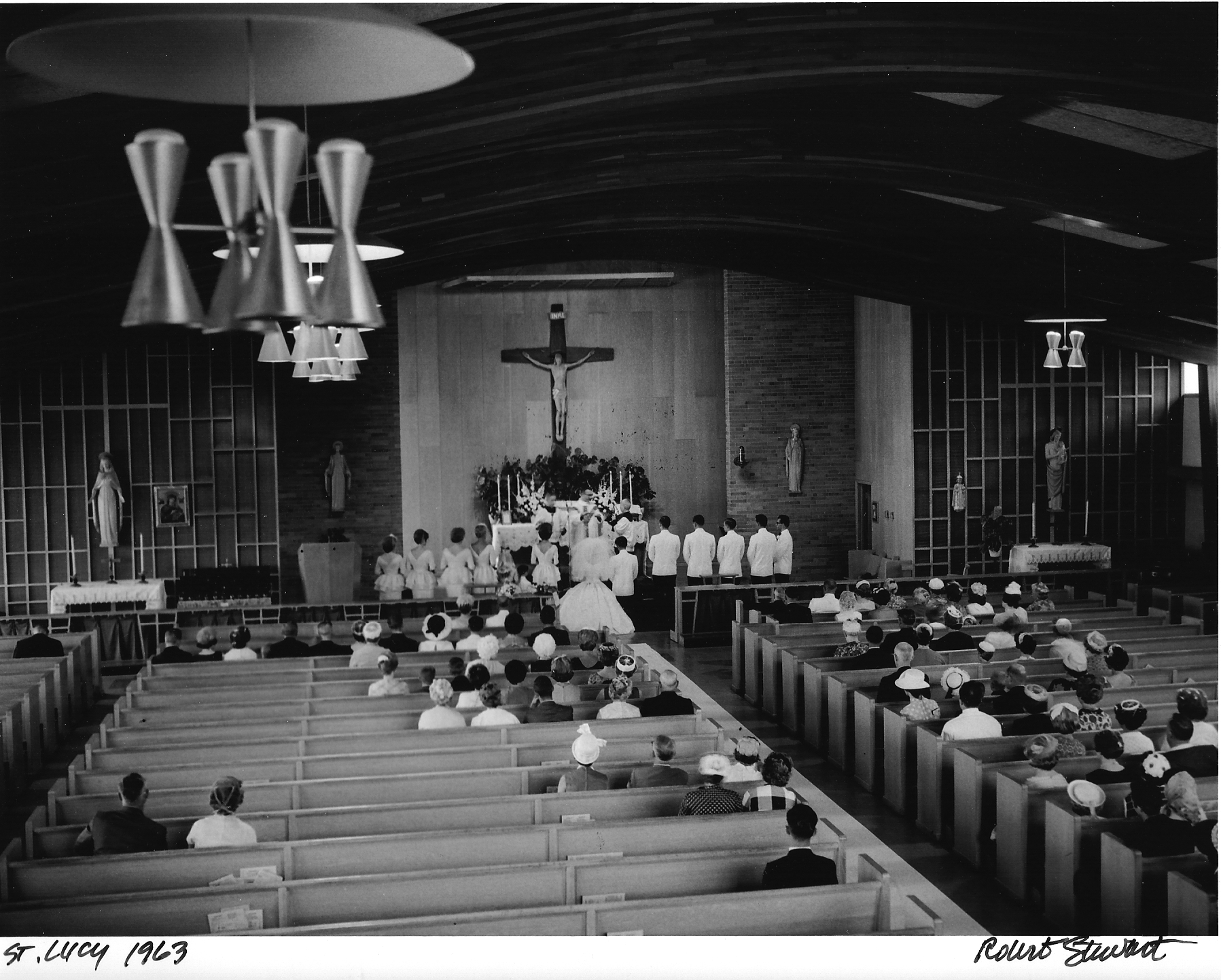——————————————————————————————————————————————————————— |
||||||
——————————————————————————————————————————————————————— |
||||||
Hours of Operation
Monday - Thursday
9:00AM - 9:00PM
Friday - Saturday
9:00AM - 5:00PM
Sunday
Closed
Holiday Hours
Saturday, November 11
Closed
—————————
Looking Back at St. Clair Shores
2019 Articles |
|||||||||||||
Looking Back at St. Clair Shores is a series of historical articles featured most months in the St. Clair Shores Sentinel newspaper. Unless noted otherwise, the photographs used are part of the St. Clair Shores Historical Commision's Photograph Collection. These photographs, along with many others, are available to view through the Digital Media Archive. Previous articles can be found by clicking on the year. |
|||||||||||||
George J. Haas House |
|||||||||||||
George J. Haas was born in Detroit on August 25, 1889, the son of a cigar maker. He attended local schools and worked for noted architect Albert Kahn. By 1930, he had his own architecture firm in Detroit. Haas would design some of the most acclaimed buildings in the area. In 1928, he was the architect for Grosse Pointe (South) High School, named the most beautiful public high school in Michigan by Architectural Digest in 2017. He designed the Macomb County Building in Mt. Clemens in 1931. He was the architect for the Jefferson Beach Amusement Park Coliseum in St. Clair Shores, for Hamtramck High School, and for the Grosse Pointe Park Municipal Building. This four-bedroom home at 31032 Jefferson Avenue in St. Clair Shores was designed by Haas for his family. The house was built sometime between 1922 and 1924, and covers over 3,000 square feet. In the 1930 US census, it was valued at $75,000. Haas lived in the home with his wife Elizabeth, and their four children, Grace, George, Hope, and Sally, for less than 15 years. By 1940, the Haas’ had moved to Plymouth, MI for George’s work for Great Lakes Steel. George Haas died in Miami, Florida in 1956 but his beautiful home still graces Jefferson Avenue today, although this photo is from 1986. |
|||||||||||||
St. Clair Shores Ambulance |
|||||||||||||
Today, most people associate emergency rescue and ambulance services with the fire department, but in St. Clair Shores transport of injured patients was the responsibility of the Police Department until 1949, even though the Fire Department had been established in 1927. Like many communities after World War II, St. Clair Shores realized they were facing increased numbers of vehicle accidents as well as a rise in heart attacks. Nationally, those rising numbers spurred better ambulance design. The development of closed cardiac massage and effective mouth to mouth resuscitation also influenced the equipment that ambulances would carry. By 1962 when this photo of an ambulance and patient resuscitation demonstration was taken, the St. Clair Shores Fire Department would make a total of 1,309 ambulance runs for the year. A total of 1,235 people were transported to hospitals. The single biggest category of ambulance runs was for injuries as a result of motor vehicle accidents (202). The next largest category of ambulance trips was because of a variety of other assorted injuries and heart attacks. Four babies were delivered in St. Clair Shores as part of ambulance transport in 1962. Today, all St. Clair Shores Firefighters have both fire and paramedic training. |
|||||||||||||
1933 Plane Crash |
|||||||||||||
On June 18, 1933, 21-year-old Frederick Stearns II decided to take his biplane up for a spin. Literally. Stearns had decided to try spins in the craft he had owned for two years. Departing from Gratiot Airport, he piloted the plane up to 4,000 feet and put the plane into a spin. Unable to halt the spin, he bailed out of the plane at 1,000 feet. Stearns landed at Martin Road and Harper Avenue, with virtually no injuries. The plane, shown in this photograph surrounded by curious passersby and at least one police officer, “spattered its wreckage in a field at Yale and Greater Mack” according to an article in the Detroit Free Press headlined “Stearns Leaps as Plane Spins”. The motor of the plane buried itself into the ground while other parts of the wreckage were scattered in an area of more than 100 square feet. At the time, there were few buildings in the area, so no person or property suffered injury or damage as a result of the plane’s crash. Stearns, the son of Frederick S. Stearns, the owner of a Detroit pharmaceutical company, had learned to fly at age 16. The crash was his first mishap, but only the third time he had ever worn a parachute while flying. He later pursued a career in aviation in California. |
|||||||||||||
St. Clair Shores Public Library Bookmobile |
|||||||||||||
For more than two decades, the people of St. Clair Shores had the Library come to them, via a bookmobile. For at least part of that time, this bookmobile was the only one operating in Macomb County. Purchased in 1959, the first bookmobile started with a two-day-a-week schedule in 1960. By 1972, it operated about 100 days each year, serving approximately 10,500 patrons. In 1974 the bookmobile was making eight stops between 8 Mile Road and 10 Mile Road, and nine stops between 12 Mile Road and 14 Mile Road. This meant the bookmobile traveled about 1,500 miles per year. Pictured here, the interior of the first bookmobile is shown with librarian John Wivo and some of the books. In 1975, the 14-year-old vehicle was replaced with a new model. An 18-foot-long, 96-inch-wide bookmobile was purchased from the Gerstenslager Company of Wooster, Ohio. The company had been manufacturing commercial vehicles since 1860, when they were horse-drawn. $32,000 of city and federal funds paid for the new bookmobile, which featured book shelves that held about 3,000 volumes, a desk and locker, a removable table, a clock, bulletin board, and heating and air conditioning. At the rear of the bookmobile, patrons would find a padded seat where they could browse their selections before checking out. From 1976 to 1980, about 200 books circulated each day the bookmobile was in operation. In 1976, 22,000 books circulated through the bookmobile. At any bookmobile stop, patrons could check out books, pay fines, or make special requests for books to be brought for them the next time. The bookmobile had regular stops in the neighborhoods, at schools and nursing homes, and at Leisure Manor, a home for senior citizens. The staff that operated the vehicle included a librarian and a clerk-driver, who worked in the Library building on the days they were not on the road. Due to budget cuts, bookmobile service in St. Clair Shores was discontinued in 1982. The city Department of Public Works auctioned the bookmobile in 1985. |
|||||||||||||
Driscoll’s Steak House Restaurant |
|||||||||||||
This building was built in the late 1880s on the west side of Jefferson Avenue at Labadie Road (now 10 Mile Road) on the Labadie family farm. It was used as a sgrocery store, operated at various times by both the Bennett and Labadie families, until it became Driscoll’s Steak House in the 1940s, as shown here. A local 1951 phone book lists the address of Driscoll Steak House as 24937 Jefferson. In the accompanying advertisement, the restaurant hours were listed as 4:30 PM to “midnite” but at that time, the steak house was not a year round business. It was open May 1 to January 1, while being closed for the winter months. An undated Driscoll’s menu (estimated from the late 1960s or early 1970s) lists several appetizers, seafood dishes in the $7 to $11 range, and a lot of beef. A “New York Strip Sirloin Steak” was $8.50 as was the “Prime Steer Filet Mignon”. The “Roast Prime Rib of Beef au Jus” was $7.50. If a diner wanted a baked potato and sour cream instead of the included hash browns, there was a 60 cent additional charge. Driscoll’s closed in the mid to late 1970s. By 1979 another restaurant was started in the building: Bobby Moore’s Blind Fish. The restaurant was re-named as a steak house in 1995. The building was destroyed by fire on September 14, 1997. |
|||||||||||||
Blue Star Mothers War Memorial |
|||||||||||||
The Blue Star Mothers of America were organized in Flint, Michigan on February 2, 1942 as a patriotic service organization in response to the bombing of Pearl Harbor. Admission was open to any woman who had a son or daughter in the Armed Forces. The goals of the organization were to work on legislation, hospital care, rehabilitation, community service and child welfare. Shortly after the national organization was formed, state and local chapters were founded. The Blue Star Mothers of St. Clair Shores was chapter #21. Among other projects, the local Blue Star Mothers raised funds toward the erection of a monument to honor those from the area serving in the military. That World War II monument is pictured here, with Mrs. Glenn Youngs, the Blue Star Mothers president in 1947, to the immediate left of the Memorial. To the right of the Memorial is Mrs. William Ehlow, the first St. Clair Shores Blue Star Mothers president and chair. The Memorial was located at 27705 Jefferson Avenue (the northwest corner of Jefferson and 11 Mile Road) in front of the St. Clair Shores City Hall and Police Department (from 1935 to 1962). Currently, the 40th District Court occupies the property. The monument project was conceived in 1942 and the first deposit into the account for it was made in February 1943, in the amount of $8.50. On Sunday, June 29, 1947, the monument was dedicated. It was designed by Brown and Raisch Company of Detroit. The granite base was inscribed on the front with the names of 33 St. Clair Shores men who died in World War II. On the reverse was a prayer for those who had served in the War and returned home. On the top of the monument was a bronze bowl that concealed a floodlight which turned on with the streetlights at night and switched off in the morning. A somewhat modified monument can be seen today at Veteran’s Memorial Park, 32400 Jefferson Avenue. The St. Clair Shores chapter of the Blue Star Mothers was active through the 1950s. |
|||||||||||||
St. Clair Shores’ “Duck” Boat |
|||||||||||||
Originally designed for the US military, DUKW (pronounced “duck”) boats were a modification of a 2 ½ ton truck. These amphibious vehicles were created to aid US, and later Allied, forces in difficult, wet conditions. They saw their first combat use in Europe in 1943, as part of the Sicilian invasion. They were also used in the D-Day landings at Normandy, and in Guam and Saipan in the Pacific Theater. The vehicles top speed on roads was 50 miles per hour, and just over 3 mph in water. General Motors built the DUKWs at plants in Pontiac, Michigan and in St. Louis. 21,147 of them were produced from 1942 to 1945. Meant to be used only in conflict zones, the boats were used again in the Korean War. By the late 1950s, most of the DUKWs in the US were designated as military surplus, and were frequently re-purposed as rescue vehicles by fire departments or for use at Coast Guard Stations. This particular vehicle is pictured in front of one of the St. Clair Shores Fire Stations about 1958. Norm Goeschel is pictured in the vehicle, which required only one person to operate it. And the acronym? D stands for: designed in 1942, U: utility, K: all-wheel drive, and W: dual-tandem rear axles, according to GM model nomenclature. |
|||||||||||||
Harper Avenue Businesses |
|||||||||||||
Reid’s Drugs was located at 25100 Harper Avenue in St. Clair Shores (at 10 Mile Road); this photo is from the 1950’s. In an ad from the local phone book, the store said they provided “sick room and baby supplies” and was open from 9 AM to 11 PM. By 1957, the store was open 24 hours a day, and offered free delivery. Also by 1957, there were two additional Reid’s Drugs in St. Clair Shores: one at 22352 Nine Mile Road (near Greater Mack) and another at 27702 Harper Avenue (near 11 Mile Road). Today, all three of the former Reid’s Drug locations currently have a drug store at the same (or almost the same) location. Another storefront in this photo is the office of the St. Clair Shores Herald, at 25104 Harper Avenue. The Herald, a weekly publication, had previously been known as the Gratiot Herald, with offices on Mack Avenue. In 1953, the paper moved to 23710 Harper (near Pleasant Street) and then relocated again to the address shown in this photo at a later date. The Herald was published from at least 1949 to 1993. |
|||||||||||||
Bennett’s Market |
|||||||||||||
There has been somewhat of a “beer tradition” at 25113 Jefferson Avenue in St. Clair Shores since the mid-1930s. John and Helen Bennett opened Bennett’s Market at that location (north of 10 Mile Road) about 1934. Their original store had been opened about 1923, but less than a decade later, they moved to the 25113 Jefferson location. Their general store sold cigars, soft drinks, candy, meats, groceries, and yes, beer. John F. Bennett was born in Thompsonville, Connecticut on March 29, 1895 to Morris and Margaret Bennett, both Irish immigrants. On John’s 1917 World War I draft card, his occupation was listed as “butcher”. He served in the U.S. Navy from 1917 to 1919. John married another Connecticut native, Helen McMonen, whose father also was an Irish immigrant, when they were both about 24. The young couple moved to Michigan soon thereafter. The Bennett family (son John Jr. was born in 1919 in Detroit) lived next to their store on Jefferson Avenue for several years, but by 1940 had moved to a house on Bon Brae Street. The 1940 US Census lists John Bennett Sr. as “proprietor—retail grocery” who worked 70 hours per week. Mrs. Bennett did not work, according to census records. Mr. Bennett died in 1979; Helen Bennett lived another six years, but Bennett’s Market was open until the mid-1990s. In 2015 the location was transformed into Baffin Brewing Company, but the outline of the original brick building is still readily recognizable to anyone who remembers Bennett’s Market, as seen in this photograph from the 1940s. |
|||||||||||||
St. Lucy Church Wedding |
|||||||||||||
St. Lucy Roman Catholic Parish was established in 1954 by Edward Cardinal Mooney as a mission of another St. Clair Shores parish, St. Joan of Arc (which itself had been established in 1927). Ground was broken for both a church and an elementary school in March of 1954. St. Lucy Mission was elevated to parish status by Cardinal Mooney on January 26, 1956; the parish’s first pastor was Msgr. Hubert A. Maino. The Catholic community of St. Clair Shores was expanding rapidly in the mid-1950s, since another parish was also established in the city in 1954: St. Isaac Jogues. This photograph from 1963 shows an unidentified couple at the altar with their attendants during the marriage ceremony inside the Church, which is still located at 23401 Jefferson Avenue. The photography was done by Robert Stewart. |
|||||||||||||
Dyer's Riding Stables |
|||||||||||||
Much of the early history of St. Clair Shores is rooted in agriculture and trades related to the land. With affluence increasing in the 20th century, some of the more practical farm pastimes were taken up by people able to afford leisure pursuits. One of these activities was horse riding. The 1928 Macomb County phone book lists Dyer’s Riding Stables on Mack Avenue in St. Clair Shores. The phone number was listed as ROSville 326. By 1937, the same phone number was listed for the St. Clair Shores Riding Club at 20603 Pleasant Street in St. Clair Shores. Since Pleasant crosses what is both Little Mack and Mack Avenues, it is reasonable to assume that both addresses referred to the same riding operation. Family notes indicate the stables were on Grove near Pleasant Street. Joseph Dyer came to the US from England and worked as the manager of a riding academy in Detroit. Mr. Dyer’s son, John Dewey Deyer (the spelling of names differ in various records) married Lauretta Langevin Sullivan in Mt. Clemens on December 10, 1928. By 1930, according to the US Census, they were living in St. Clair Shores at 20597 Pleasant Street and Mr. Dyer was the “riding master at a Private Club”. The Riding Club (or Riding Stables) was listed in local telephone books into the early 1950s. By that time, two other riding stables were located in the Shores, including Jack’s at 19712 Ten Mile Road. Jack’s offered “instruction, wooded trails, English and western saddles, and Hay Rides.” By 1955 however, there were no longer any riding stables in St. Clair Shores. This family photograph shows Loretta Dyer with horse “Sweetheart” in front of the St. Clair Shores Riding Club about 1938. The Club had facilities for riding both inside the building (pictured) as well as outdoors. |
|||||||||||||




















